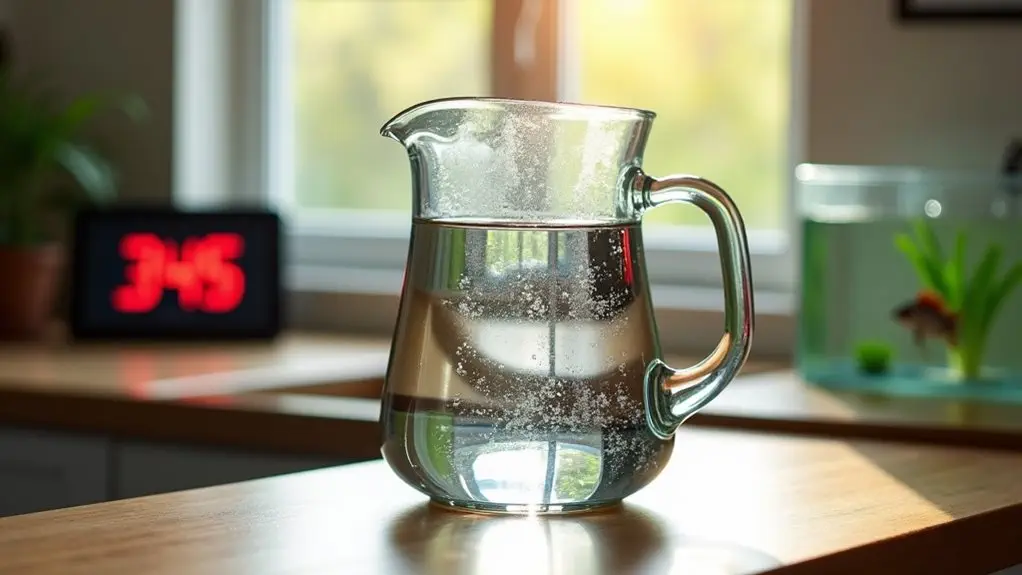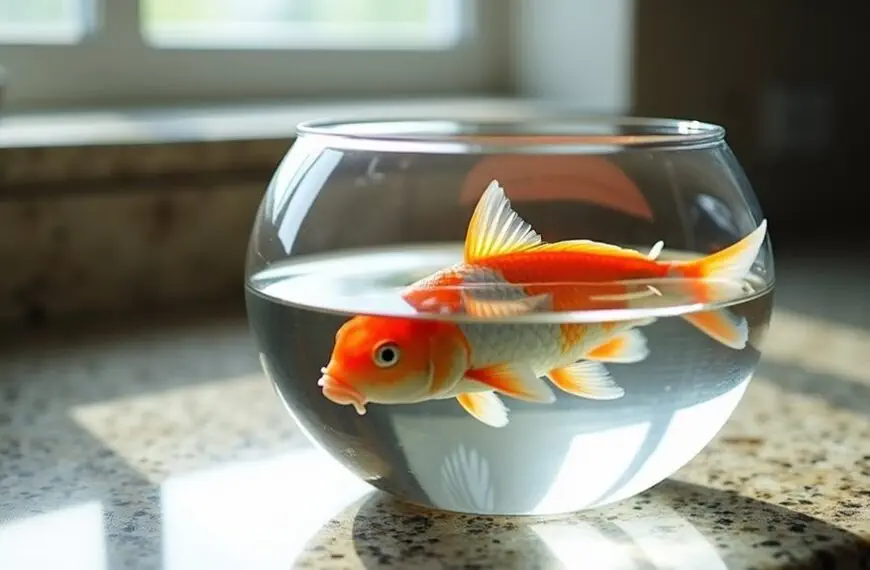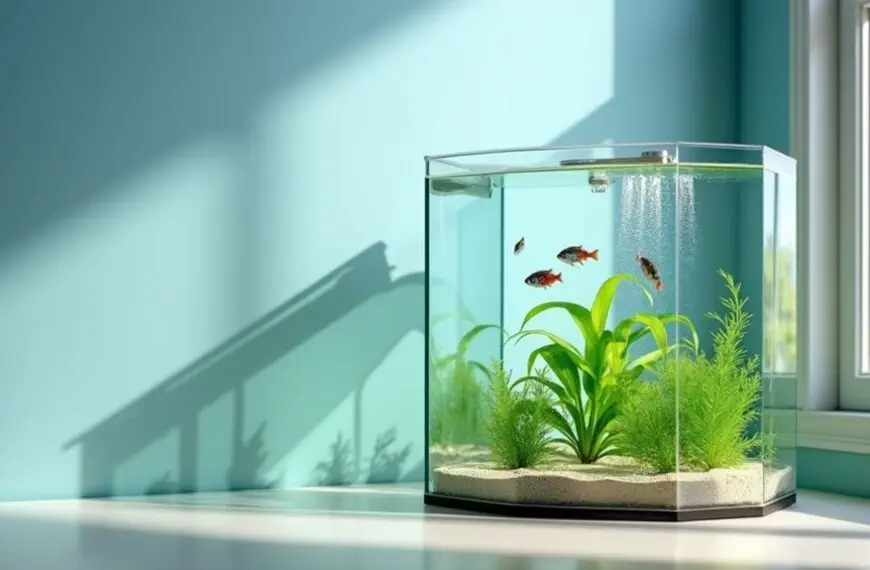While letting tap water sit for 24-48 hours can help remove chlorine naturally, it's not always the safest method for your finned friends. You'll want to use a water conditioner for immediate results, especially since many water supplies now use chloramine, which won't evaporate on its own. Add 1mL of conditioner per 10 gallons of water, and you can safely introduce fish within 15-30 minutes. If you're going the natural route, using an air stone can speed up chlorine removal to about 12-24 hours, but remember to test your water parameters first. There's much more to creating the perfect aquatic home than just waiting it out.
Contents
- 1 Tap Water Safety for Fish
- 2 Natural Dechlorination Time Requirements
- 3 Chemical Treatment Vs Waiting Period
- 4 Signs of Safe Water
- 5 Water Testing and Parameters
- 6 Fish Species Considerations
- 7 Best Water Aging Methods
- 8 Professional Tips for Success
- 9 Frequently Asked Questions
- 9.1 Can I Use Bottled Spring Water Instead of Treating Tap Water?
- 9.2 Does Using an Air Pump Speed up the Dechlorination Process?
- 9.3 Will Activated Carbon Filters Remove Chlorine From Tap Water?
- 9.4 Does Boiling Water Remove Beneficial Minerals Needed by Aquarium Plants?
- 9.5 Can I Mix Old Tank Water With New Tap Water?
- 10 Final Thoughts
Tap Water Safety for Fish
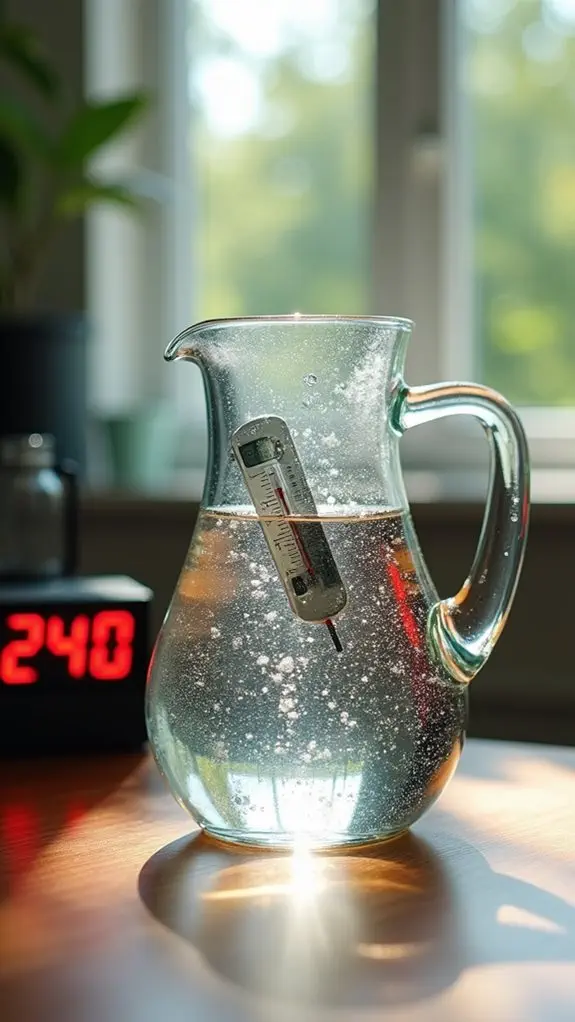
Anyone keeping fish needs to understand that tap water isn't immediately safe for aquatic life. Your tap water contains several contaminants that can harm or even kill your finned friends, including chlorine, chloramine, and heavy metals. These tap water contaminants need to be properly addressed before you introduce any fish to your aquarium. Ammonia poisoning from untreated tap water can cause gill redness and loss of appetite in fish.
To protect your fish health, you'll need to take specific steps to make tap water safe. While letting water sit for 24 hours can help evaporate chlorine, it won't remove chloramine or heavy metals. That's why using a quality water conditioner or dechlorinator is essential – it's like giving your tap water a safety makeover! These products come in liquid or tablet form and work quickly to neutralize harmful chemicals. For optimal results, consider using reverse osmosis filters to eliminate both chlorine and heavy metals effectively. Additionally, regular water quality checks ensure that no toxic buildup occurs once the fish are introduced.
Don't forget about monitoring pH levels, too. Different fish species have their own pH preferences, and sudden changes can stress them out. It's like moving from a cozy house to an ice-cold swimming pool – not very comfortable! Regular testing with a pH kit will help you maintain the perfect environment for your underwater pals.
Natural Dechlorination Time Requirements
Naturally removing chlorine from tap water requires patience and proper timing. If you're using natural aeration, you'll need to wait 24 to 48 hours before your water is safe for fish. Surface agitation helps maintain oxygen levels throughout the dechlorination process. Maintaining optimal water quality parameters is crucial for the health of your fish, so ensure all elements are balanced before introducing them to the tank.
While this method works well for chlorine, it won't tackle chloramine, which is becoming more common in tap water these days. Failing to properly dechlorinate can be toxic within hours to your aquatic pets.
For the quickest and most reliable results, you've got two main options: natural aeration or the boiling method. Here's what you need to know about timing:
- Natural aeration with an air stone takes 24-48 hours, but you can speed it up by increasing surface agitation.
- Boiling water for 15-20 minutes removes both chlorine and chloramine, though you'll need to let it cool completely.
- Placing water in direct sunlight while aerating can reduce waiting time to 24 hours.
- Using multiple methods together (like sunlight plus air stones) can improve efficiency.
Chemical Treatment Vs Waiting Period
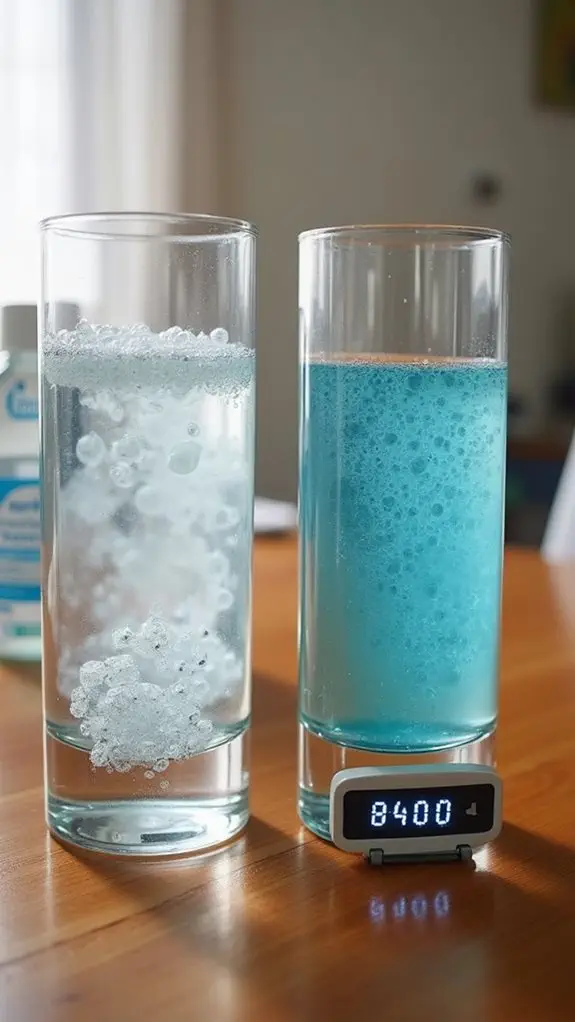
You'll find chemical water conditioners are your quickest route to fish-safe water, with products like API and Seachem making tap water safe in just minutes. Additionally, these conditioners often contain stress-reducing ingredients that can help support your fish during the transition to their new environment.
While letting chlorine naturally evaporate can take 24-48 hours, chemical treatments work instantly and protect your fish from harmful substances like chloramine that won't evaporate on their own. Using 1mL per 10 gallons of water ensures proper treatment with API Tap Water Conditioner. Regular testing of water parameters after treatment helps confirm the water is safe for fish.
If you're enthusiastic to add fish to your tank, chemical treatments offer the safest and most reliable option, giving you peace of mind without the lengthy wait.
Instant Chemical Dechlorination Benefits
Chemical dechlorinators offer several key advantages over the traditional waiting method when preparing tap water for aquarium use.
When you're enthusiastic to add new water to your tank, you'll find that chemical dechlorination advantages include both convenience and reliability. You won't have to plan ahead or leave buckets of water sitting around your home for days. Instead, you can achieve instant water safety with just a few drops of the right product. These products are particularly valuable since specialized dechlorinators are required to remove chloramine from treated water supplies.
Studies show the chemical neutralization process takes 2 to 5 minutes to completely eliminate chlorine from your water. Additionally, maintaining optimal water quality involves regular testing of parameters to ensure a healthy environment for your fish.
Here are the main benefits you'll enjoy when using chemical dechlorinators:
- Immediate effectiveness – Your water becomes fish-safe within seconds of adding the treatment.
- Consistent results – Unlike natural evaporation, chemical treatments reliably remove both chlorine and chloramines.
- Stress reduction – You'll protect your fish from harmful chemicals while adding a protective coating to their scales.
- Flexibility in application – You can either pre-treat water or add the product directly to your tank during water changes.
With chemical dechlorinators, you're not just saving time – you're providing better protection for your aquatic friends.
They'll thank you with their vibrant activity and healthy appearance, making your aquarium maintenance routine both easier and more effective.
Natural Evaporation Time Requirements
Traditionally, aquarists have relied on two main methods for making tap water safe for fish: natural evaporation and chemical treatment.
While the evaporation efficiency of letting tap water sit might seem like a safe, chemical-free option, you'll need to wait 1-5 days for chlorine to naturally dissipate. You can speed up this process by using an air stone, which reduces the waiting time to 12-24 hours. Most local water supplies contain 1.5 ppm chlorine, making proper treatment essential. Maintaining optimal water parameters is crucial to ensure that your fish remain healthy and stress-free.
However, there's a catch – this method only works if your tap water contains chlorine alone, not chloramine. Since many water treatment facilities now use chloramine, which doesn't evaporate, you might be unknowingly putting your fish at risk of chlorine exposure. It's recommended to double dose conditioners when dealing with chloramines due to their complex chemical structure.
If you're determined to use the natural evaporation method, you'll need to confirm what's in your tap water first. Test strips can help you determine if you're dealing with chlorine or chloramine.
For most aquarists, using a dechlorinator is the more practical choice – it works within minutes and removes both chemicals. Plus, you won't have to play the waiting game or worry about whether you're actually making your water safe for your finned friends.
Signs of Safe Water
The key to identifying safe aquarium water lies in observing several physical and chemical indicators. You'll want to check the water clarity first – it should be crystal clear, like looking through a pristine window.
When you're setting up your tank, proper oxygen levels are essential for your finned friends to thrive, and you can often spot this through their behavior.
- Watch for water that's completely transparent, without any unusual colors or floating particles that might spell trouble for your fish.
- Take a good sniff – safe water shouldn't have any strange odors that make your nose wrinkle.
- Test the water temperature to verify it's in the right range for your specific fish species.
- Monitor your fish's behavior – if they're swimming normally throughout the tank (not just at the surface), that's a great sign.
You'll also want to keep an eye on chemical balances, particularly the pH level and chlorine content. Remember, essential water treatment methods like dechlorination are crucial to ensure that the water is safe for your aquatic pets.
Think of it like creating the perfect swimming pool – except this one's for your aquatic pets! Remember, if something seems off about your water, it's better to wait and test again than risk your fish's health.
Water Testing and Parameters
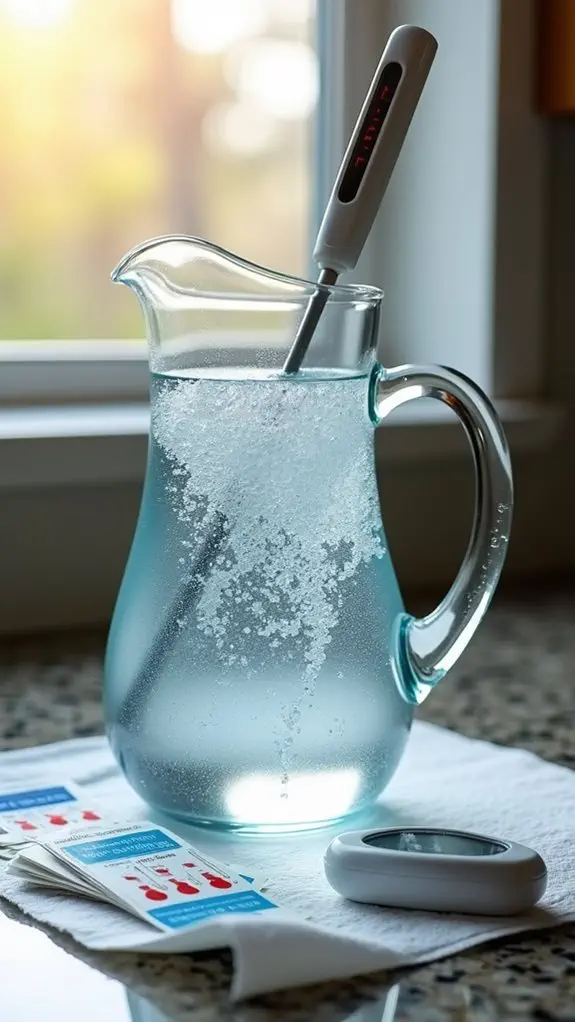
You'll need to test for key water parameters like pH (ideally between 6.5-7.5), ammonia, nitrites, and nitrates to guarantee your aquarium water is fish-safe. Testing isn't just about dipping strips in water – you're looking for any signs of toxicity that could harm your future fish friends, so it's worth investing in a reliable liquid test kit. Regular testing helps you catch problems early, and you'll feel more confident knowing your water's ready for its upcoming underwater residents. Additionally, maintaining optimal ammonia levels is crucial to prevent stress or mortality in your fish.
Essential Water Testing Parameters
Before adding fish to your aquarium, understanding essential water parameters is essential for maintaining a healthy aquatic environment.
You'll need to monitor several key factors to guarantee your fish thrive in their new home. The nitrogen cycle is particularly important, as it directly impacts your filtration efficiency and determines whether your tank is safe for aquatic life.
Here's what you'll need to test regularly:
- Ammonia, nitrite, and nitrate levels – these are your water quality indicators and should be checked twice weekly.
- Water hardness (GH and KH) – affects your fish's comfort and helps maintain stable pH levels.
- Water temperature – must remain consistent to prevent stress on your fish.
- Phosphate levels – particularly significant if you're planning to keep live plants.
Testing isn't just about dipping strips in water; it's about understanding your aquarium's health. Additionally, ensuring that the water parameters align with those needed for choosing compatible fish is crucial for maintaining a peaceful community.
Think of it as taking your tank's essential signs! Use reliable testing kits and keep a log of your readings.
Ideal Ph Level Range
Maintaining proper pH levels stands as a cornerstone of successful aquarium keeping, with most freshwater fish thriving in a range between 6.5 and 8.0.
You'll find that different fish have evolved to prefer specific pH ranges based on their natural habitats – think of it as their comfort zone. South American fish, for instance, enjoy slightly acidic conditions, while African cichlids are living their best lives in more alkaline waters.
When you're setting up your aquarium, you'll want to pay close attention to pH stability, as sudden pH fluctuations can stress or even harm your finned friends.
It's like changing the temperature of your shower from just right to freezing cold – not a pleasant experience! You should regularly test your water's pH and make any necessary adjustments gradually.
Remember, the pH scale is logarithmic, which means a change from 7 to 6 is actually ten times more acidic – that's a bigger shift than you might think! Additionally, keeping ammonia toxicity in mind when adjusting pH can prevent stress for your fish.
For community tanks, aim for a neutral pH around 7.0, as this accommodates most fish species and helps maintain a peaceful underwater neighborhood where everyone can thrive.
Toxicity Detection Methods
Regularly testing your aquarium water for toxicity levels remains vital for maintaining a healthy environment for your fish.
You'll want to identify potential toxicity sources and establish a consistent testing frequency to guarantee your aquatic friends stay healthy. Modern testing kits like the API Aquarium Master and PetMD Fish Tank Test make it easy to monitor essential parameters such as pH, nitrates, and ammonia.
To make water testing a breeze, here's what you'll need to do:
- Check test kit expiration dates and store them properly to maintain accuracy
- Collect water samples in clean containers, avoiding contamination
- Follow manufacturer's instructions precisely for each parameter test
- Document your results to track changes over time
You don't need to be a scientist to test your water effectively! Whether you're using test strips or liquid reagents, consistency is key.
Remember to test more frequently when cycling a new tank or after making changes to your aquarium. For tap water specifically, you'll want to test both before and after treatment with water conditioners to guarantee it's safe for your fish.
Implementing regular maintenance practices, such as performing water changes, helps to further improve the water quality and reduce toxicity levels over time.
Different toxicity sources can affect your readings, so maintain a regular testing schedule to catch potential problems early.
Fish Species Considerations
Different fish species have unique requirements for their aquatic environment, and these variations directly impact how long you'll need to condition your tap water.
For example, if you're planning to keep sensitive species like salmon or trout, you'll want to be extra careful since they require cooler water temperatures between 45-68°F and higher oxygen levels of 5-12 mg/L.
On the flip side, hardier fish species like catfish and carp can tolerate a broader range of conditions, with comfortable temperatures between 65-80°F and lower oxygen requirements of 3-10 mg/L.
You'll still need to condition your tap water, but these fish might forgive a slight parameter slip-up now and then! Hybrid striped bass fall somewhere in the middle, preferring warmer waters between 70-85°F.
Remember that while most fish species share similar pH tolerances (6-8), their temperature and oxygen needs vary considerably.
That's why it's vital to research your specific fish species before setting up their new home.
Think of it like preparing a custom-tailored suit – one size definitely doesn't fit all when it comes to creating the perfect aquatic environment!
Best Water Aging Methods
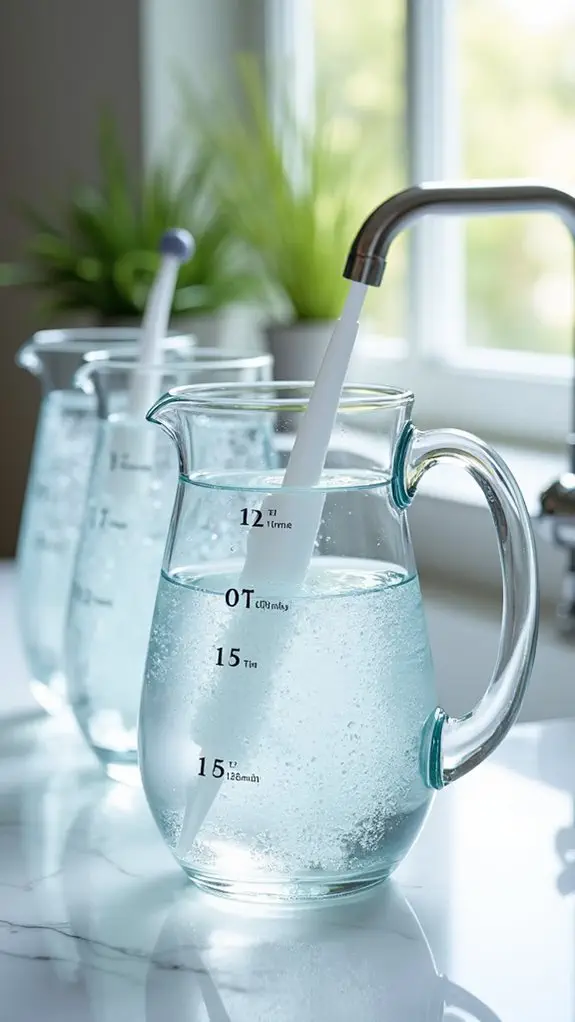
Now that you understand how different fish species respond to water conditions, let's look at the most effective methods for aging tap water.
You've got several reliable options that'll help create a safe environment for your finned friends, and they're all pretty straightforward to implement.
Here are the top methods for aging your tap water properly:
- Set up a dedicated aging container with water circulation from an air pump and maintain consistent temperature with a heater – this is the traditional 24-hour method.
- Use a quality water conditioner like Seachem Prime, which instantly makes tap water safe and eliminates waiting time.
- Combine biological filtration with sodium thiosulfate treatment for thorough chloramine removal and proper cycling.
- Install an airstone and heater in a separate bucket while monitoring water parameters throughout the process.
Professional Tips for Success
Success with your aquarium starts with mastering professional-grade water treatment techniques. You'll want to focus on water conditioner efficiency to guarantee your fish stay healthy and stress-free.
While it's tempting to rush the process, waiting 24 hours after treating tap water gives you the best results and helps avoid those dreaded fish health impacts that can occur from hasty introductions.
For the best outcome, you'll want to combine several proven methods. Start by using a high-quality water conditioner that matches your tank size, and don't skimp on the treatment time – those 15-30 minutes really matter!
Consider using an airstone during the waiting period to improve circulation and oxygen levels. You might think your water looks ready sooner, but trust us, patience is your best friend here.
Keep a close eye on your water parameters using test kits, and don't forget to monitor pH levels regularly.
If you're dealing with particularly sensitive fish species, you might want to take the extra step of professional water testing to guarantee everything's perfect.
Frequently Asked Questions
Can I Use Bottled Spring Water Instead of Treating Tap Water?
Yes, you can use bottled spring water with its benefits of ready minerals and convenience. However, watch for spring water drawbacks like varying mineral content and higher costs, especially for larger tanks.
Does Using an Air Pump Speed up the Dechlorination Process?
Yes, your air pump can speed up dechlorination by increasing surface agitation and oxygen exchange. While it's an effective method, you'll still need 24-48 hours for complete chlorine removal through aeration alone.
Will Activated Carbon Filters Remove Chlorine From Tap Water?
Yes, you'll find activated carbon filters are highly effective at removing chlorine from tap water. They're one of the most reliable chlorine removal methods, with efficiency rates above 90% through adsorption and chemical reactions.
Does Boiling Water Remove Beneficial Minerals Needed by Aquarium Plants?
Yes, boiling effects will remove beneficial minerals your aquarium plants need. While it eliminates impurities, you'll lose essential calcium and magnesium through this process. You'll need to add mineral retention products for plant health.
Can I Mix Old Tank Water With New Tap Water?
Yes, you can mix old tank water with new tap water. It's a good tank maintenance practice that helps maintain stable water quality. Just make sure you dechlorinate the tap water first and make gradual changes.
Final Thoughts
You've now got all the tools to create a safe aquatic home for your fish! Remember, waiting 24-48 hours for tap water to dechlorinate naturally is ideal, but you can speed things up with water conditioners. Whether you're setting up a new tank or doing water changes, always test your parameters and watch for signs of safe water. Your fishy friends will thank you with their vibrant colors and happy swimming!

